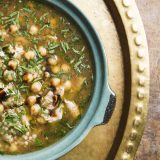It was my first lesson in making maftool, an Arab pasta similar to couscous. It starts with a grain of bulgur rolled by hand with flour and a hint of water into a small round, much like Italian fregola. It is smaller than moghrabieh, a similar couscous often found in Lebanon.
I had arrived in Israel’s Galilee Valley two days before, hosted by Reem Kassis, author of “The Palestinian Table.” I was at the Ezba restaurant as a guest of husband-and-wife co-owners Habib and Minerva Daoud. Habib’s family moved from Lebanon in 1820, just one example of the politics that make Galilee both melting pot and touchpoint for the Middle East’s complicated history.
Minerva, the appointed cooking teacher, set up in the lower dining room. She is ever-patient and, during my stay, never without a smile. Though I’m a misanthrope by nature, watching the Daouds, still very much in love, was both exhilarating and supportive of the notion of food as social elixir. Minerva began with the bulgur in a wide, battered metal container with short sides and, using her palm with fingers outstretched, rolled the grains while adding small amounts of flour, just a few tablespoons at a time, alternating with drizzles of olive oil mixed with water and copious amounts of cardamom. Once the maftool was the right size, she transferred it to a round metal sieve with wooden sides, similar to a bam- boo steamer, and shook it to remove excess flour as well as sort out grains of the wrong size.
Though I’m a misanthrope by nature, watching the Daouds, still very much in love, was both exhilarating and supportive of the notion of food as social elixir.
Meanwhile, the kitchen was bustling, in full production for lunch with smeediyeh (fine bulgur mixed with caramelized onions and greens, including dandelion, mallow and purslane), hashweh (the word means stuffing, a mix of rice and meat with allspice, cinnamon and nutmeg), mounds of finely chopped parsley, an enormous sack of dried red chilies, freekeh (smoked wheat berries, cracked and dried, often served as a pilaf), boiling stocks and, of course, maftool, which also is the name of a dish that includes onions and chicken.
First, the maftool grains are steamed using a metal sieve/bowl fitted over a stockpot of simmering water, sealed around the sides with a flour paste. Then chicken is boiled in water with allspice, bay leaves and onions. More onions are sautéed, then the chicken broth is added to make a fortified chicken-and-onion broth. The maftool, the pasta that we had just made, is added along with bite-size pieces of the cooked chicken and chickpeas. (In this recipe, the maftool also serves as thickener.) I was intrigued that onions form the foundation for this recipe, serving as a flavoring and a key ingredient in the broth. Habib and Minerva use a lot of onions.
Lunch was a feast, a dozen dishes that completely covered the large round table, including slices of eggplant fried and topped with a dressing of lemon, garlic and ground Aleppo pepper; greens; salads; and, of course, the maftool, which turned out to be my favorite.
Habib spoke about the importance of food. He said, “Food belongs to people, not places,” an interesting take on the everything-local mania that has swept the food world. But watching the Daouds at work that morning, their body language in close proximity, and how their world was bathed in simmering broths, grains and finely minced herbs, one readily agrees that the two of them owned their food and their food owned them. It is their food, not ours, and so the giving of their food to strangers was an act of communion, another example of the ancient and enduring rite of hospitality.




